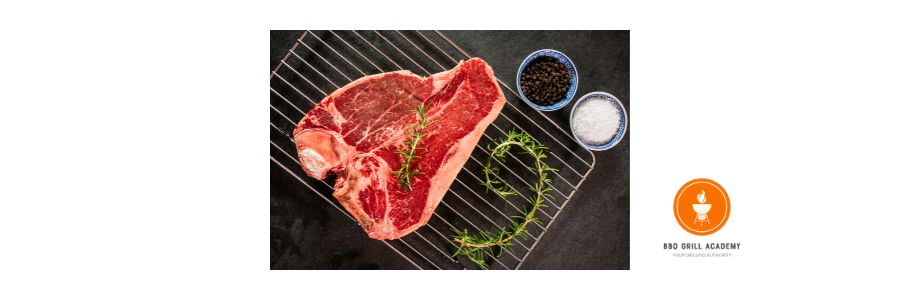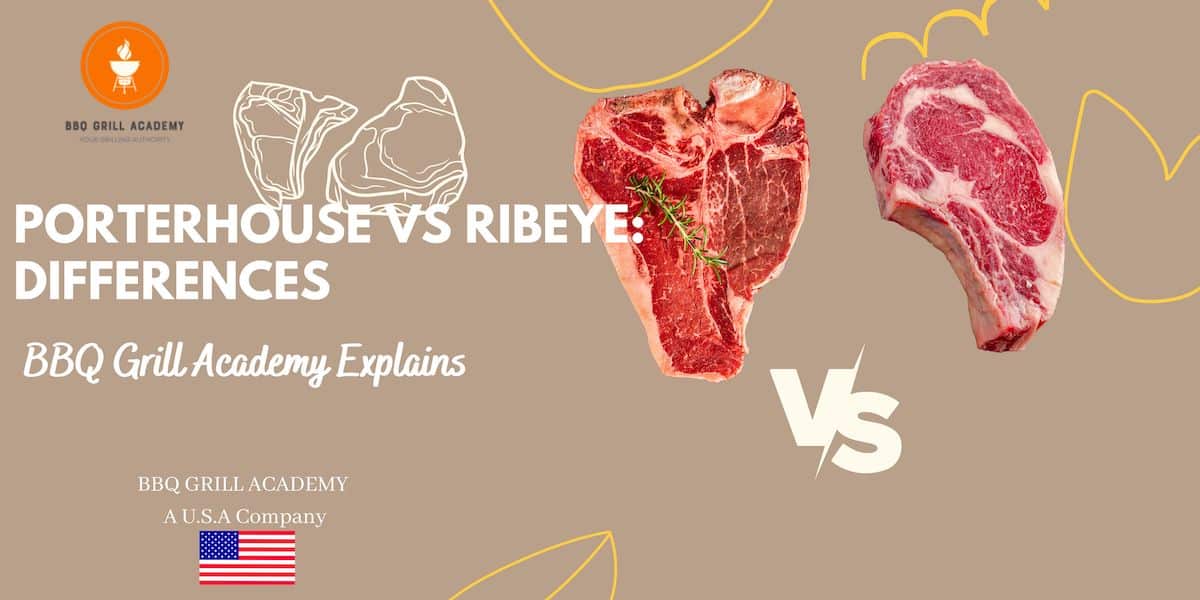Many of our readers have asked us to compare a porterhouse and a ribeye steak. Which one is better? How to tell the difference between the two and how to identify them if they are placed on a plate in front of you.
Both are amazing and tasteful cuts of meat. Both steaks pack a punch of flavor, are easy to cook, and are great for grilling. However, there are some differences between these two cuts of meat.
In this article I will explain the main differences between these two cuts, talk a bit about their flavor profile and how to identify them. Put on your seat belt; you are on for a meaty ride.
Let define what a Ribeye Steak is
Ribeye is a delicious, tender steak and very popular due to its rich fat content and marbling. One of the most delicious aspects of a ribeye is the marbling. These steaks are very flavorful and are great for cooking on a grill because the fat protects the steak from drying out and remains juicy. Normally, ribeye steaks are smaller than porterhouse steaks, but these steaks can be cut as large as 8 pounds.

The ribeye comes from the ribs of the cow. It is also known as the spinalis dorsi, its anatomical name is or also known as the ribeye cap. This steak can also be trimmed as a cowbow steak or tomahawk.
Ribeye Flavor Profile
As far as the flavor of a porterhouse vs ribeye, I prefer a ribeye because its fat content makes the meat very juicy even on a high heat cook. Compared to a porterhouse, the ribeye is very tender an the porterhouse has a stronger beef flavor.
Now Lets define what a porterhouse steak is
A porterhouse is easily identifiable by its size and shape. This steaks are large and carry have a tear drop kind of shape. A porterhouse steak can wight up to two pounds and its larger size and ticker cut is what differentiated from is slimmer lighter brother the T bone steak. The T bone steak is a smaller, slimmer steak cut with a smaller tenderloin portion, the porterhouse is a cut closer to the rear end of the short loin containing a larger portion of tenderloin ( fillet mignon) and strip.

There are also specifications defined by the U.S department of Agriculture [1] which states that a porterhouse suggest weight should be 10 to 12 ounces and its maximum width in relation to the parallel length of the back bone, one and a quarter inch thickness. This is important because is one of the difference on a porterhouse and a T bone steak.

Both steaks are the same cut and come from the same part of the animal and both have that recognizable T-shaped bone.
The porterhouse packs a lot of flavor as it offers two cuts of the steak, a tenderloin (the fillet mignon ) and a strip steak (the New York strip) split between the bone. The porterhouse steak is cut from the tenderloin and the top loin, joined by the bone which is why you get two steaks and why this steak is so flavorful and popular.
Porterhouse Flavor Profile
The porterhouse taste is beefy with a good balance of flavor and tenderness. It is does not have as much aft and marbling as a ribeye but it still has a tender texture. Unlike in ribeye steaks, this cut has a stringer beef flavor and different texture profiles to to the tenderloin portions and the strip, the trip side being slighter tougher than the tenderloin.
The Difference: Porterhouse vs Ribeye
The first and most obvious difference is where the actual steak cut is from. There are eight primal cuts of beef. These are the first meat cuts from the cow carcas. From these primal cuts, different subprimal cuts are butchered, including porterhouse steaks.
The porterhouse steak is a subprime cut from the loin, more specifically the lower back portion. The loin is a relatively inactive muscle in the cow that runs along the spine.
The ribeye is another subprimal cut extracted from the ribs, the rib being the primal cut. As its name suggests, this steak is from the upper area of the rib and is well known for its slightly “salty” beef flavor. This is because a ribeye steak has a higher fat content than a porterhouse steak and it is noticeable. Ribeye steak can also be trimmed and cut in different ways, making either a cowboy steak, a tomhawk steak or just a ribeye. Surprisingly, the only difference is whether the rib bone is attached and its length.
Then there is flavor
Porterhouse steaks have a stronger beef flavor than ribeyes. This is due to the lower fat content in porterhouse steaks. Ribeyes have a higher fat content and more marbling . Expect the ribeye to have a very rich flavor and the porterhouse to be a tad more balanced with a stronger beef flavor. Because ribeyes have more fat, it is easier to cook these steaks to higher temperatures and doness levels. The fat keeps the meat juicy during long cooking and renders well during a high sear.
Tenderness and Texture
Somethings things like flavor and texture c an be subjective but the ribeye thanks to all its marbling and fat will feel more tender. The porterhouse will have a combination of tenderness and toughness due to its two cuts, tenderloin and the strip; the strip being a tougher cut.
Fat Content difference of ribeye and a porterhouse
This is also a major distinction. Ribeye has a lot of fat, and the marbling difference is obvious. Porterhouse steaks contain some fat, but not as much as ribeye steaks.
In ribeyes you will notice a wide spread of marble throughout the entire cut and often a thin outer ring of fat on one side. A porterhouse, on the other hand, still has fat and some marbling, but not as pronounced as on a ribeye steak.
Appearance of each Steak Cut
The porterhouse steak has a t-shaped bone with two different cuts, and its overall T shape is very recognisable. The ribeye is taken from around the rib, whereas the porterhouse is carved from the loin. The shape of these two steaks is very reconfigurable. The porterhouse contains a “T” shaped bone which sahpes the meat around it and keeps that “T” shape, and the ribeye has a rounder shape to it.
Price
Price is another area where these steak differ. This is one hard point to score because meat prices change all the time. Also there are different grades of of meat, everything from choice, prime and even black grade influence the price of the meat.
But here is what I go by, I look at top of the online suppliers and monitor their prices and prices I found are from of the US top meat suppliers. I personally use and recommend Snake River Farms, the short story on them, the provide most high end restaurants and businesses with impeccable cuts of meat and most BBQ and Grilling Pros use them too.
As you might know the USDA has a beef grading scale to let consumer knows the quality of the meat. The are other guides out there but the USA beef grades are the standard and the guide used across the US. This guide grades the marbling and thus quality of the meat,
One thing to know is the higher the grade the more expensive the steak will be. The grades USDA Prime, USDA Choice, and USDA Select [2]. Black grade is above USDA prime, yeap, think about melts in your mouth juicy steak.
Porterhouse
A two pound Black Grade porterhouse will cost about 130 dollars. This is the highest grade wagyu meat money can by but if you want a real steak, this is it. Now this is top grade, best in town steak. This is the type of cut you likely find at a high-end restaurant. On everage you can find a porterhouse steak for about 17 dollars per pound and up. Of course the better the quality expect to pay more.
Ribeye
On the other hand two pounds of black grade wagyu ribeye will run you about 155 dollars. Now I’m comparing two of the best cuts and highest grade of steak you can buy but you get the point. In average this steak will cost you about any where from 20 to upwards of 70 dollars per pound depending on its grade. I always find myself going with the ribeye, although more expensive at times, because I truly enjoy its flavor.
So you can see there is a good price different between these too steal cuts. I have seen steak prices change a lot over the last months but when comparing a porterhouse vs ribeye the always seems to be the more expensive steak.
One Last Word
When comparing a porterhouse vs ribeye, side by side the first difference is their visual appearance. The porterhouse has that distinguishable T bone and T shape whereas ribeye steaks have a lot of marbling and a tear shape. Both are great steaks but if you want the biggest bang for your buck the portions on porterhouse.
Refrences:
[1] https://www.ams.usda.gov/sites/default/files/media/IMPS_100_Fresh_Beef%5B1%5D.pdf
[2] https://www.usda.gov/media/blog/2013/01/28/whats-your-beef-prime-choice-or-select





